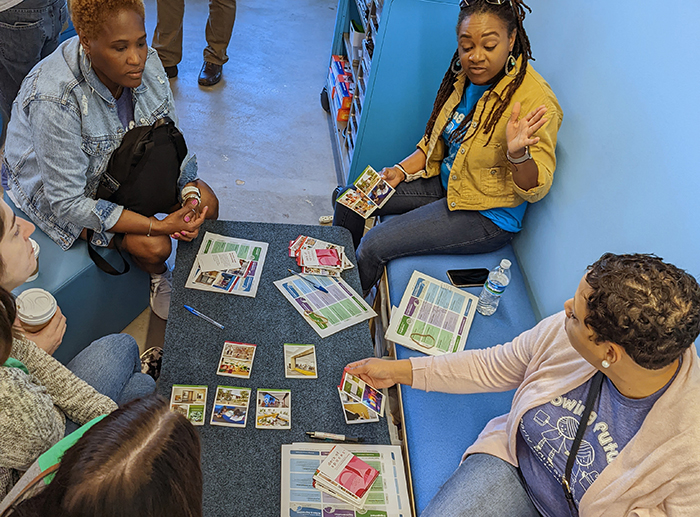Deck of Spaces, cards designed to maximize educational space usage, spread to schools around the world
 LAWRENCE — Playing cards might not be considered a traditional school activity, but the Deck of Spaces has educators thinking about how they can make the most of schools, classrooms and the spaces in which students learn. The deck, developed as a collaboration among education researchers at the University of Kansas, architects, teachers and learners, has been adopted by schools around the world to inspire conversations and new ideas about how schools can maximize their physical spaces, whether building a new school or rearranging existing environments.
LAWRENCE — Playing cards might not be considered a traditional school activity, but the Deck of Spaces has educators thinking about how they can make the most of schools, classrooms and the spaces in which students learn. The deck, developed as a collaboration among education researchers at the University of Kansas, architects, teachers and learners, has been adopted by schools around the world to inspire conversations and new ideas about how schools can maximize their physical spaces, whether building a new school or rearranging existing environments.
James Basham, professor of special education at KU, has devoted much of his career to researching and furthering universal design for learning, an educational approach that focuses on design for the needs and abilities of all students by removing barriers in the learning environment. Through his work he met David Reid, principal of Multistudio, an interdisciplinary design firm with a studio in Lawrence. Their discussions resulted in Deck of Spaces, developed as a way to encourage more interaction at educational conferences.
Featuring pictures of physical spaces on one side and questions on the other, they proved immediately popular at events. The developers then began selling them as a fundraiser, and their popularity boomed, now being used in schools in the United States, Europe and Australia. The decks’ success in inspiring people to reimagine the best research-backed way to use school spaces also secured their creators this year’s Core77 Design Awards’ Notable Interaction Award. The annual awards honor all areas of design enterprise, with an emphasis on excellence and inclusivity. The K-12 deck’s second edition also was honored with a San Francisco Design Week Award, which recognizes the intersection of ideas, design, business and entrepreneurism.
“We’re trying to help transform educational spaces to be student-centered. Being able to provide an image with discussion topics and integrated research is critically important,” Basham said. “We’ve seen these decks help people think differently. All educators are designers of the learning environment and experience. Whenever design doesn’t work in life, we go through the redesign process, and we have to do so continually in education.”
Multistudio and KU researchers have developed both a K-12 deck, which is now in a second edition, and a higher education deck. They are working on a Spanish-language deck as well. Each card in the K-12 deck is part of a theme: student experiences, educator experiences, or paradigms and school culture. One side features photos of various educational spaces while the other features discussion such as how spaces can be used to achieve goals, such as engaging students, encouraging faculty collaboration or making facilities such as the school library part of a larger community. The deck also features cards with vignettes of a teacher, their level and subject matter, and goals they hope to accomplish for their students. It then asks users to consider how that teacher can maximize the space and resources they have to achieve those goals.
While students and teachers use educational spaces the most, many other people — including architects and researchers — influence the design. The Deck of Spaces is designed to bring people from all backgrounds together to discuss ideal use of educational facilities while considering things from each other’s perspectives and contributing their own expertise. Basham said he can also use the decks to help the future teachers he educates consider how best to maximize space in alignment with the research-backed principles of universal design for learning.
“The physical environment itself is often overlooked in schools, but is critical in making educational improvements,” he said. “That’s often because it is viewed as endemic. I learned very early on even simple things like painting can improve the learning environment. Even if we work to improve curriculum, the physical plant needs to be viewed on the same level of importance.”
Michael Ralph has considered the issue of optimal classroom use from multiple angles. Vice president and director of research at Multistudio, Ralph is one of the co-authors of Deck of Spaces and was a teacher as well. While completing his doctorate at KU, he also conducted research on optimal uses of learning spaces on college campuses.
“The Deck of Spaces can help educators think more creatively and inclusively about their learning environments. As a former classroom teacher, I know the impact seeing new approaches to space design can have in the way I design my own classroom,” Ralph said. “The deck is filled with interesting and provocative imagery that helps me imagine entirely new paradigms for how the school itself can become another teacher. Thoughtful design can make a teacher’s job easier, a student’s learning experience more productive and the whole school environment more inspiring and inclusive.”
Top image: Early childhood educators use the Deck of Spaces to discuss maximizing school spaces. Image credit: Multistudio